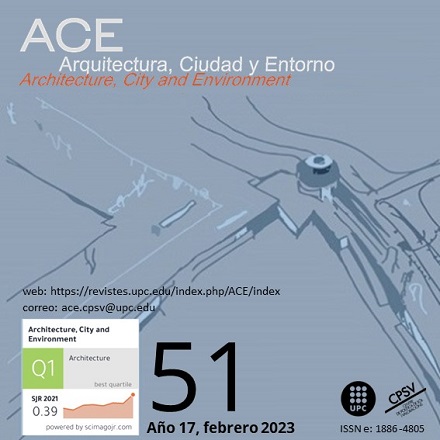Barragan in Morocco: A Newfound Identity
DOI:
https://doi.org/10.5821/ace.17.51.11881Keywords:
Travel, vernacular architecture, North of Africa, MexicoAbstract
Years after his first two journeys in which he was fascinated by the gardens of the Alhambra and Ferdinand Bac first, and later by avant-garde rationalist architecture, Luis Barragán set out -at the age of fifty and at a time of maturity and revaluation of the local- on a third tour of Europe that ended with a month-long trip to Morocco in January 1953. Familiar with the experiences in North Africa of the artists Miguel Covarrubias and Mathias Goeritz, the decision to travel through the Atlas lands was a consequence of the desire to visit its traditional architecture -deeply linked to the landscape- in a concern common to other twentieth-century architects who preceded him on his journey. Primitive architecture without architects had pushed Gunnar Asplund and Le Corbusier first, followed later by Jorn Utzon, Alvar Aalto, Sverre Fehn and Luis Barragán, among others, to travel through North Africa, in a renewed interest in the landscape and local traditions, becoming part of what Kenneth Frampton called Critical Regionalism, characterized by the relationship between place and culture, customs and architecture. After that transcendental and unknown journey, Barragán's work manifested an austere, abstract, labyrinthine, and interior spatial language, a synthesis of the memory of his native Mexico and the discovery of the astounding land of the Atlas: What did Luis Barragán see to say that the trip to Morocco was the one that made the greatest impression on him in his life?
Downloads
Published
Issue
Section
License
| INTELECTUAL PROTECTION CRITERIA |
At this moment, it is count with the "Oficina Española de Patentes y Marcas", while global protection it is being processed by the World Intelectual Property Organization (OMPI/WIPO). Nevertheless the International Standard Serial Number Office (ISSN) has given the following numbers ISSN: 1886-4805 (electronic version) and 1887-7052 (paper version). All articles will be peer reviewed, using double blind reviewing. |
| COPYRIGHT |
The article contents and their comments are authors exclusive liability, and do not reflect necessarily the journal editor commitee's opinion. All ACE published works are subject to the following licence CC BY-NC-ND 3.0 ES http://creativecommons.org/licenses/by-nc-nd/3.0/es/ It implies that authors do not hold nor retain the copyright without restrictions but only those included in the licence. |


































